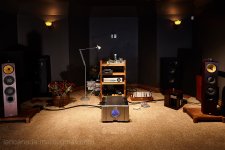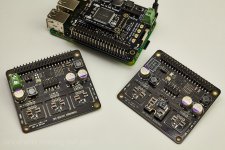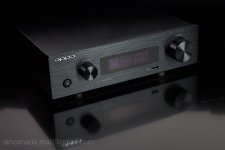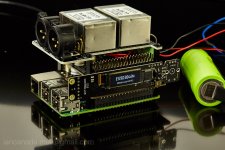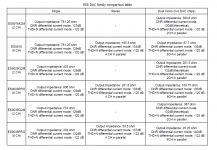One more off topic post: Working with external ES9038Q2M DAC
This new RPi adapter makes RPi and ESS controller very easy and clean to work with external DAC such as ES9038Q2M. All cables are standard.
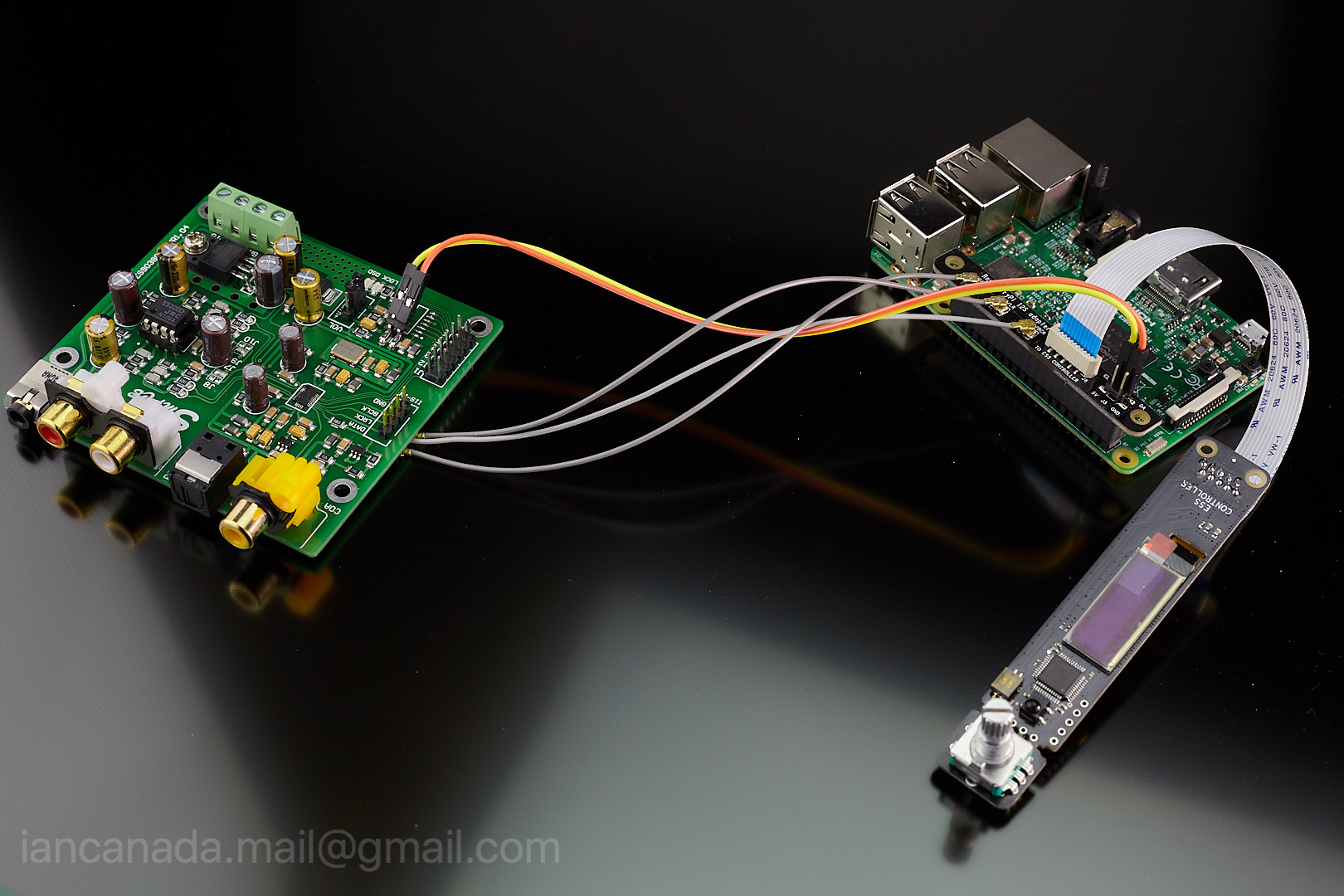
NewRpiI2SAdapter4 by Ian, on Flickr
This new RPi adapter makes RPi and ESS controller very easy and clean to work with external DAC such as ES9038Q2M. All cables are standard.

NewRpiI2SAdapter4 by Ian, on Flickr
Again, I'm highly recommended using an IsolatorPi to isolate the external ES9038Q2M DAC from both RPi and ESS controllor.
The new PRi adapter is doing perfect job for this kind of application.
But I would suggest waiting for my IsolatorPi II, which will have the non-isolated GPIO connector pre-installed.
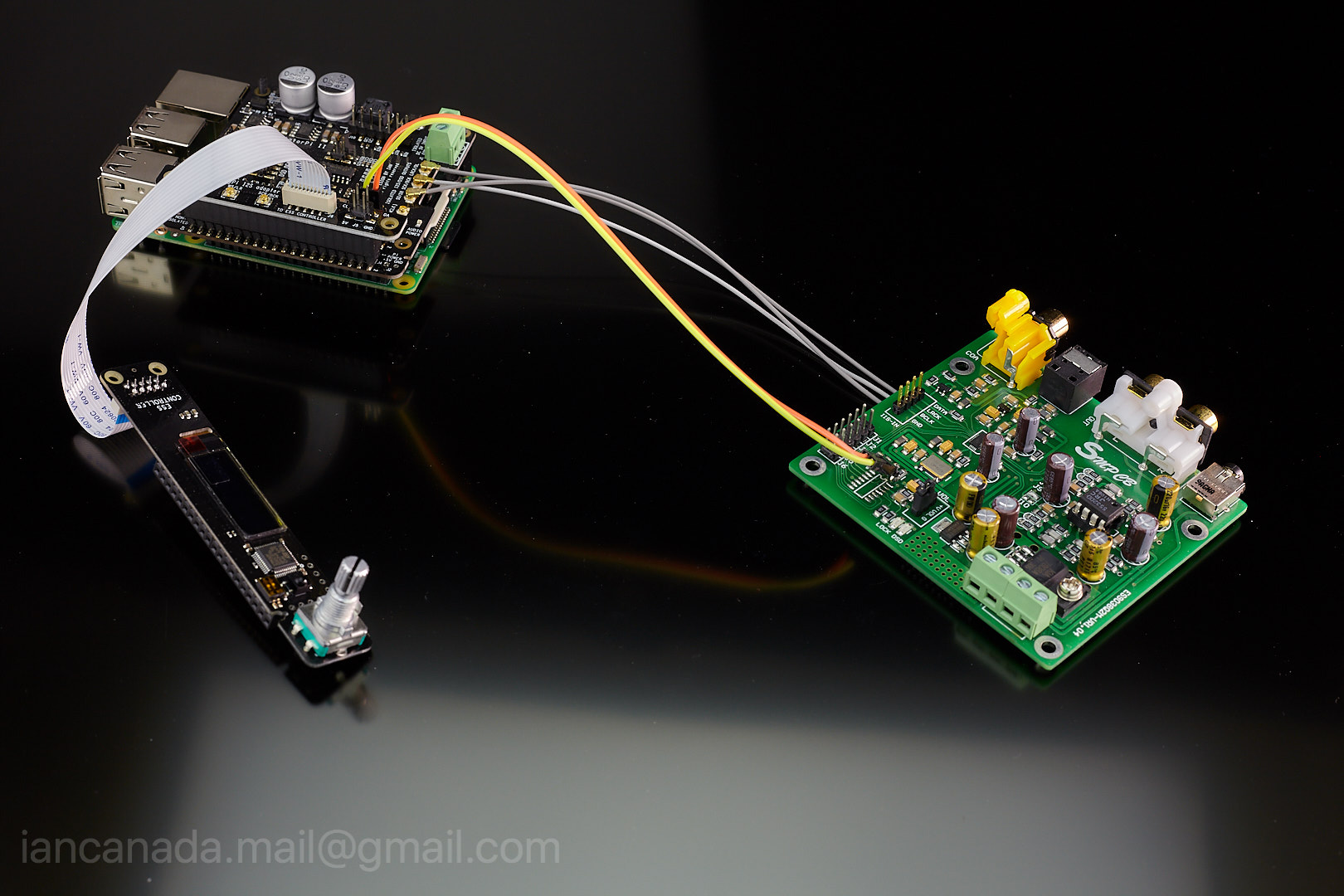
NewRpiI2SAdapter6 by Ian, on Flickr
The new PRi adapter is doing perfect job for this kind of application.
But I would suggest waiting for my IsolatorPi II, which will have the non-isolated GPIO connector pre-installed.

NewRpiI2SAdapter6 by Ian, on Flickr
ES9038Q2M DAC HAT vs ES9028Q2M DAC HAT vs ES9038Pro DAC (1): Testing result
I spent whole long weekend doing the listening test. It was fun. I enjoy the experience. But trying to distinguish tiny differences back and forth many times in between still makes me feel a bit hard.
Anyway, here are the summarized testing result:
ES9038Q2M DAC HAT
Sweet and warm sound, style has been improved and slightly different from ESS previous generation. Very good bass, rich and musical.
Sound stage is wide but not very deep.
Good atmosphere and air. But Image is a bit bigger, closer and flatter.
A bit less dynamic. Also, a bit less clarity at low volume level sound. Sound density is also not as good as ES9028Q2M DAC HAT.
Loudness level is lower than other two DAC under same configuration. Need to adjust the volume of my PASS XP-10 5 steps higher.
Doesn’t feel tired after long time listening.
ES9028Q2M DAC HAT
Classical ESS sound, style is pretty much closed to my BII ES9018DAC . Very nature, original sound with perfect every small details.
Sound stage is wide and deep.
Image is smaller and sharper. Vivid 3D feelings. More liquid.
Very good dynamic and low volume clarity. Solid and high density. Small sound level instruments can be easily noticed from the dark background.
Doesn’t feel tired after long time listening.
ES9038Pro OPPO Sonic DAC
Best dynamic, best bass, best middle range and high range. Sweet and warm sound with solid highest density. Very rich and musical. Perfect details, especially for low volume sound. Good atmosphere. Style has been improved from previous ESS generation.
Sound stage wide and deep. Focusing is very good, but the image is a bit bigger than I expected.
Slightly noisy than ES9028Q2M and ES9038Q2M DAC HAT. Feels a little bit tired after long time listening. After repeat listening to same music many times, also feels not as nature as ES9028Q2M, but just a little bit.
Ian
I spent whole long weekend doing the listening test. It was fun. I enjoy the experience. But trying to distinguish tiny differences back and forth many times in between still makes me feel a bit hard.
Anyway, here are the summarized testing result:
ES9038Q2M DAC HAT
Sweet and warm sound, style has been improved and slightly different from ESS previous generation. Very good bass, rich and musical.
Sound stage is wide but not very deep.
Good atmosphere and air. But Image is a bit bigger, closer and flatter.
A bit less dynamic. Also, a bit less clarity at low volume level sound. Sound density is also not as good as ES9028Q2M DAC HAT.
Loudness level is lower than other two DAC under same configuration. Need to adjust the volume of my PASS XP-10 5 steps higher.
Doesn’t feel tired after long time listening.
ES9028Q2M DAC HAT
Classical ESS sound, style is pretty much closed to my BII ES9018DAC . Very nature, original sound with perfect every small details.
Sound stage is wide and deep.
Image is smaller and sharper. Vivid 3D feelings. More liquid.
Very good dynamic and low volume clarity. Solid and high density. Small sound level instruments can be easily noticed from the dark background.
Doesn’t feel tired after long time listening.
ES9038Pro OPPO Sonic DAC
Best dynamic, best bass, best middle range and high range. Sweet and warm sound with solid highest density. Very rich and musical. Perfect details, especially for low volume sound. Good atmosphere. Style has been improved from previous ESS generation.
Sound stage wide and deep. Focusing is very good, but the image is a bit bigger than I expected.
Slightly noisy than ES9028Q2M and ES9038Q2M DAC HAT. Feels a little bit tired after long time listening. After repeat listening to same music many times, also feels not as nature as ES9028Q2M, but just a little bit.
Ian
Attachments
ES9038Q2M DAC HAT vs ES9028Q2M DAC HAT vs ES9038Pro DAC (2): About my test
The listening test is base on my own system. A lot of subjective and physiologic factors were involved. So, the result may not be exactly correct. Different people may have different listening experience.
Why transformer I/V stage?
The reason I use transformer I/V stage for the test is that the transformer is a passive component. In this configuration, no active component such as OP amplifier and power supply will affect the sound quality of I/V stage. It also has no any feedback. So the finial sound will be more up to DACs themselves.
Why LifePo4 battery for power supply?
Performance of new ultra-low noise LDOs are already very good, such as LT3042, ADM7151/4 and TPS7A4700. Though their noise level can be pretty much closed to battery, but the sound quality is still not as pure and clean as battery. What’s the key difference between battery and LDO?
One thing might be overlooked by most of people. Yes, the dynamic performance!
We call them the load and line transient response. LDO is based on voltage feedback. It control the output current by sensing the changing of output voltage from an internal reference. So, there is no way to eliminate the response time and wave. Even for LT3042, the output response voltage wave can reach up to two digits of mV. Battery is a pure passive component without any feedback. Battery transient response performance will be 100% decided by internal resistance. LifePO4 battery has very low internal resistance, so the dynamic performance can be much better than any LDO.
That’s the reason I use LifePo4 battery as DAC power supply for test.
Why FIFO re-clock and Isolator?
Though ESS declared that they have the best jitter reduction technologies in the world, but to push ESS DAC into higher sound quality level, we still need to run it at SYNC clock mode rather than default ASRC mode. More and more people, even ESS themselves are realized this fact. So, the SYNC clock from FIFO with digital isolator is a must for high-end listening test.
Why CCHD957 45.1584/49.1520 MHz?
CCHD-957 XO is one of the best ultra-low phase noise oscillators at affordable price. The phase noises are only around -130dBc/Hz at 100Hz offset and around -100dBc/Hz at 10Hz offset. They are second to Pulsar based on my previous listening test.
Why fully balanced XLR analog output configuration?
Balanced configuration has higher dynamic range and less noise sensitive than SE configuration. That’s why high-end audio amplifiers and DACs are all have balanced input and output. With balanced configuration, it will be much easier to distinguish small difference between details, sound image and focusing than the SE configuration. I personally like balanced configuration very much. I use them as possible as I can for my daily listening, except for the time I use my 300B or 2A3 amplifier. But they are for some taste not for performance and serious listening.
Ian
The listening test is base on my own system. A lot of subjective and physiologic factors were involved. So, the result may not be exactly correct. Different people may have different listening experience.
Why transformer I/V stage?
The reason I use transformer I/V stage for the test is that the transformer is a passive component. In this configuration, no active component such as OP amplifier and power supply will affect the sound quality of I/V stage. It also has no any feedback. So the finial sound will be more up to DACs themselves.
Why LifePo4 battery for power supply?
Performance of new ultra-low noise LDOs are already very good, such as LT3042, ADM7151/4 and TPS7A4700. Though their noise level can be pretty much closed to battery, but the sound quality is still not as pure and clean as battery. What’s the key difference between battery and LDO?
One thing might be overlooked by most of people. Yes, the dynamic performance!
We call them the load and line transient response. LDO is based on voltage feedback. It control the output current by sensing the changing of output voltage from an internal reference. So, there is no way to eliminate the response time and wave. Even for LT3042, the output response voltage wave can reach up to two digits of mV. Battery is a pure passive component without any feedback. Battery transient response performance will be 100% decided by internal resistance. LifePO4 battery has very low internal resistance, so the dynamic performance can be much better than any LDO.
That’s the reason I use LifePo4 battery as DAC power supply for test.
Why FIFO re-clock and Isolator?
Though ESS declared that they have the best jitter reduction technologies in the world, but to push ESS DAC into higher sound quality level, we still need to run it at SYNC clock mode rather than default ASRC mode. More and more people, even ESS themselves are realized this fact. So, the SYNC clock from FIFO with digital isolator is a must for high-end listening test.
Why CCHD957 45.1584/49.1520 MHz?
CCHD-957 XO is one of the best ultra-low phase noise oscillators at affordable price. The phase noises are only around -130dBc/Hz at 100Hz offset and around -100dBc/Hz at 10Hz offset. They are second to Pulsar based on my previous listening test.
Why fully balanced XLR analog output configuration?
Balanced configuration has higher dynamic range and less noise sensitive than SE configuration. That’s why high-end audio amplifiers and DACs are all have balanced input and output. With balanced configuration, it will be much easier to distinguish small difference between details, sound image and focusing than the SE configuration. I personally like balanced configuration very much. I use them as possible as I can for my daily listening, except for the time I use my 300B or 2A3 amplifier. But they are for some taste not for performance and serious listening.
Ian
Last edited:
I spent whole long weekend doing the listening test. It was fun. I enjoy the experience. But trying to distinguish tiny differences back and forth many times in between still makes me feel a bit hard.
Anyway, here are the summarized testing result:<snip>
A Chinese Taobao seller is also to find out that ES9028Q2M is more suitable for making DAC HAT.
es9028q2m Raspberry DSD I2S
Perhaps because the 9038 current output is so large that it cannot follow the design of the 9018.
Last edited:
Hmmh.
The Oppo seems to best all your own stuff. (Lets put the minor flaws out of equation. )
)
Then I'm wondering if the Oppo runs all DACs outputs in parallel ?!?!?
To me it sounds like it.
This dense and dynamic experience I'd associate with the DAC outputs in parallel in the first place. But even that is a wild guess. Putting that Oppo
side by side to your stuff, just can't lead to conclusions about the DAC chip itself, doesn't it !?!?
To be on the safe side in drawing final conclusions you'd need to build a 9038Pro HAT.
***
BTW. Have you tried a rather big supercap supply buffer?? I'd say such a buffer can replace these nice sounding - but IMO annoying, batteries.
***
Anyhow. Thx for the comparison. It's not what I'd call an "eye opener", still
it's an interesting summary...
...and to me it suggests that the best bet would be to go after a 9038Pro.
Sad - if it wouldn't.
On the other hand the pricetag of that chip doesn't really seem to justify
the invest, considering it's rather "marginal" differences.
Perhaps a Dual-Mono 9038Q2M could make a nice and affordable alternative approach to a Pro!?!?
The Oppo seems to best all your own stuff. (Lets put the minor flaws out of equation.
Then I'm wondering if the Oppo runs all DACs outputs in parallel ?!?!?
To me it sounds like it.
This dense and dynamic experience I'd associate with the DAC outputs in parallel in the first place. But even that is a wild guess. Putting that Oppo
side by side to your stuff, just can't lead to conclusions about the DAC chip itself, doesn't it !?!?
To be on the safe side in drawing final conclusions you'd need to build a 9038Pro HAT.
***
BTW. Have you tried a rather big supercap supply buffer?? I'd say such a buffer can replace these nice sounding - but IMO annoying, batteries.
***
Anyhow. Thx for the comparison. It's not what I'd call an "eye opener", still
it's an interesting summary...
...and to me it suggests that the best bet would be to go after a 9038Pro.
Sad - if it wouldn't.
On the other hand the pricetag of that chip doesn't really seem to justify
the invest, considering it's rather "marginal" differences.
Perhaps a Dual-Mono 9038Q2M could make a nice and affordable alternative approach to a Pro!?!?
Last edited:
Hi Ian, i also have same experience with es9038q2m with transformer output. I think lover current output is one of the reason, and you get not so powerful output vs both other dacs.
I have thought to try B1 buffer after transformer because one is lying in box somwhere
Another thing is which regulators are you using for all 3 voltages? One question, is pin 15 regulated with externall 1,2v regulator or comes 1,2v from internall es9038q2m regulator and is externally decoupled with caps.
Do you use for all supply pins lt3042?
I see that you bypassed ferrite coil on es9028 but not on es9038...any reason?
Is not sound more dynamic if you dont use so big coil on digital supply lines ? I dont use them because *high speed current cunsumption* is too dampened with so big coil.
Also don*t like oscon on AVCC... if you want polymer FP have fuller sound, but i prefer KZ or SILMIC on avcc... I have ordered 0.47Flov esr cap for AVCC to try it like Allo designers did.
Is difference between China es9038q2m and your dac big?
I have thought to try B1 buffer after transformer because one is lying in box somwhere
Another thing is which regulators are you using for all 3 voltages? One question, is pin 15 regulated with externall 1,2v regulator or comes 1,2v from internall es9038q2m regulator and is externally decoupled with caps.
Do you use for all supply pins lt3042?
I see that you bypassed ferrite coil on es9028 but not on es9038...any reason?
Is not sound more dynamic if you dont use so big coil on digital supply lines ? I dont use them because *high speed current cunsumption* is too dampened with so big coil.
Also don*t like oscon on AVCC... if you want polymer FP have fuller sound, but i prefer KZ or SILMIC on avcc... I have ordered 0.47Flov esr cap for AVCC to try it like Allo designers did.
Is difference between China es9038q2m and your dac big?
Last edited:
Hi Ian,
Well, that's indeed an interesting report on the various dacs.
If I'm not mistaken, the conclusion is that the Oppo is a winner, for this time.
But the Oppo has 9038 Pro, probably with an active IV-stage, which is a totally different approach.
Wouldn't it be worth - with your excellent skills - to try the 9038 Pro, either with transformer or active stage?
Or would your conclusion be, to not to put to much effort anymore in designing dacs, since there are so many good ones on the market and stick to making the ultimate player/reclocker for which there are not so many.
Kind regards,
Frank
Well, that's indeed an interesting report on the various dacs.
If I'm not mistaken, the conclusion is that the Oppo is a winner, for this time.
But the Oppo has 9038 Pro, probably with an active IV-stage, which is a totally different approach.
Wouldn't it be worth - with your excellent skills - to try the 9038 Pro, either with transformer or active stage?
Or would your conclusion be, to not to put to much effort anymore in designing dacs, since there are so many good ones on the market and stick to making the ultimate player/reclocker for which there are not so many.
Kind regards,
Frank
@Iancanada: did you use some kind of FIFO (perhaps your new RPi FIFO) in your testing?
Because if you didn't, and your ESS DAC HATs were running as I2S slaves off of the RPi's mediocre I2S output, it would stand to reason that you got mediocre performance, compared to the Oppo.
EDIT: It looks like you did use your FIFO. I didn't see it in the pictures and kindda missed it on my first read.
Because if you didn't, and your ESS DAC HATs were running as I2S slaves off of the RPi's mediocre I2S output, it would stand to reason that you got mediocre performance, compared to the Oppo.
EDIT: It looks like you did use your FIFO. I didn't see it in the pictures and kindda missed it on my first read.
Last edited:
Hmmh.
The Oppo seems to best all your own stuff. (Lets put the minor flaws out of equation.)
Then I'm wondering if the Oppo runs all DACs outputs in parallel ?!?!?
To me it sounds like it.
This dense and dynamic experience I'd associate with the DAC outputs in parallel in the first place. But even that is a wild guess. Putting that Oppo
side by side to your stuff, just can't lead to conclusions about the DAC chip itself, doesn't it !?!?
To be on the safe side in drawing final conclusions you'd need to build a 9038Pro HAT.
***
BTW. Have you tried a rather big supercap supply buffer?? I'd say such a buffer can replace these nice sounding - but IMO annoying, batteries.
***
Anyhow. Thx for the comparison. It's not what I'd call an "eye opener", still
it's an interesting summary...
...and to me it suggests that the best bet would be to go after a 9038Pro.
Sad - if it wouldn't.
On the other hand the pricetag of that chip doesn't really seem to justify
the invest, considering it's rather "marginal" differences.
Perhaps a Dual-Mono 9038Q2M could make a nice and affordable alternative approach to a Pro!?!?
Hi Soundcheck,
I'm working on some research and analysis to the testing result. I'll have more update posted very soon.
Regards,
Ian
@Iancanada: did you use some kind of FIFO (perhaps your new RPi FIFO) in your testing?
Because if you didn't, and your ESS DAC HATs were running as I2S slaves off of the RPi's mediocre I2S output, it would stand to reason that you got mediocre performance, compared to the Oppo.
EDIT: It looks like you did use your FIFO. I didn't see it in the pictures and kindda missed it on my first read.
Hi Dimdim,
Yes, I use FifoPi, which is new generation 768KHz I2S/DSD/DOP FIFO with integrated isolator. It's still not been released so I didn't show FifoPi picture.
Regards,
Ian
Hi Ian, i also have same experience with es9038q2m with transformer output. I think lover current output is one of the reason, and you get not so powerful output vs both other dacs.
I have thought to try B1 buffer after transformer because one is lying in box somwhere
Another thing is which regulators are you using for all 3 voltages? One question, is pin 15 regulated with externall 1,2v regulator or comes 1,2v from internall es9038q2m regulator and is externally decoupled with caps.
Do you use for all supply pins lt3042?
I see that you bypassed ferrite coil on es9028 but not on es9038...any reason?
Is not sound more dynamic if you dont use so big coil on digital supply lines ? I dont use them because *high speed current cunsumption* is too dampened with so big coil.
Also don*t like oscon on AVCC... if you want polymer FP have fuller sound, but i prefer KZ or SILMIC on avcc... I have ordered 0.47Flov esr cap for AVCC to try it like Allo designers did.
Is difference between China es9038q2m and your dac big?
Hi androa76,
All coils were bypassed after I use LiFePo4 battery. The picture was taken before that time. You are right, coil limits the current changing and causes ripple. I only use it for filtering switching mode power supply.
I've also tried all LT3042 power supply, but still not as good as battery power. I posted the reason in the above post.
Super capacitor helps, but not the small ones for RTC. Their ESR are too high. I'll try the big ultra-capacitor with extra-low ESR. That would be good alternative solution to batteries.
Regards,
Ian
ES9038Q2M DAC HAT vs ES9028Q2M DAC HAT vs ES9038Pro DAC (3): Analyzing the result
To develop RPi DAC HATs, I tried whole ESS mobile DAC family. ES9018K2M is the first, then ES9028Q2M, then the ES9038Q2M. I had a big hope to my ES9038Q2M DAC HAT because it’s the latest ESS mobile DAC. But the testing result is not as that good as I expected.
Though some new ESS progresses were already noticed from ES9038Q2M DAC listening test, and not as good as ES9038Pro is also reasonable, but ES9038Q2M should be better than ES9028Q2M DAC HAT in all the ranges. So I was wondering why.
I decided doing some research to the whole ESS DAC family, including both audiophile DACs and mobile DACs. Please see the attached cross reference chart for details.
After listing all mobile DACs together with their big brothers, things become very interesting.
Obviously we can see from the chat:
1. ESS uses DAC ( or DAC core) parallel technology to improve DAC performance by reducing output impedance.
2. Comparing with previous generation, ES9038Pro really has big progress and improvement. 5dB increased in DNR and 2db decreased in THD+N. Internal impedance reduced to 202 ohm from around 800 ohm at multi-channel configuration, and unbelievable 50.5 and 25.25 ohm at stereo and dual mono configuration.
One ES9038Pro almost equals to 4 ES9028Pro DACs!
3. ES9028Pro keeps almost the same specification numbers as ES9018. The improvement is minor. Maybe just some internal algorithm and processing.
4. ES9018K2M is exactly 2 ch version of ES9018(8 ch). They share same DAC core. ES9018K2M equals to 1/4 of ES9018.
5. ES9028Q2M is more than 2 ch of ES9028pro(8 ch). Actually each ES9028Q2M DAC core equals to 2 ES9028Pro DAC cores in parallel. One ES9028Q2M equals to 1/2 of ES9028Pro DAC.
6. ES9038Q2M seems not really related to its big brother ES9038Pro. If we calculate from the impedance numbers, each ES9038Q2M core equals to 0.261 of ES9038Pro DAC core, which is unreasonable. So, I don’t think it shares same DAC core with ES9038Pro. ESS also didn’t list ES9038Q2M part number on their website so far. Maybe it’s just a special OEM version with deeply optimized to cell phone application (power consumption) and also with some improvement to the internal digital filters. That explains why ES9038Q2M DAC core has much higher output impedance (for lower output current) than ES9028Q2M. For audiophiles, I believe to build ES9038Q2M DAC HAT in dual mono configuration would be a better solution than just single chip stereo configuration.
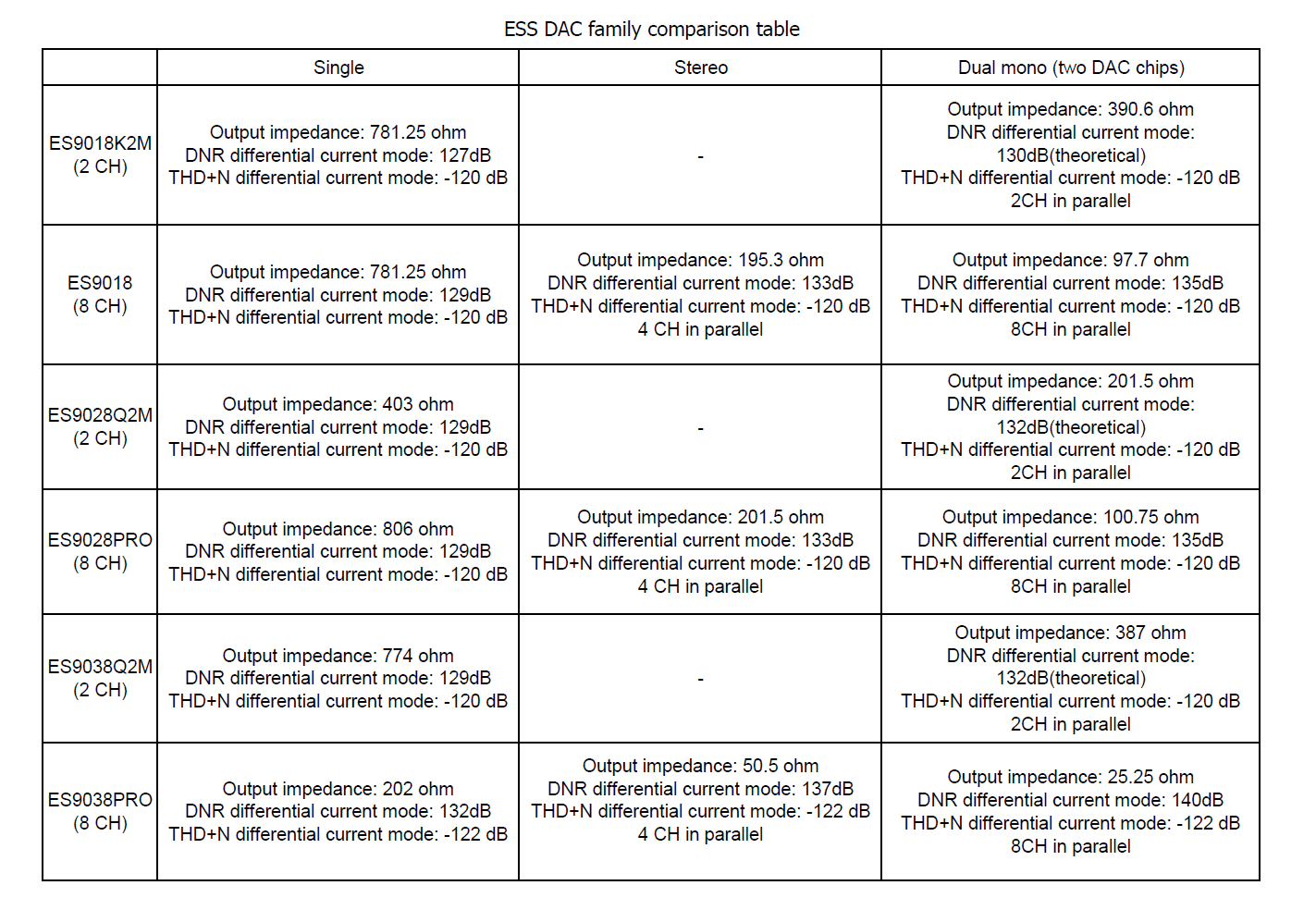
EssDacComparisonTable by Ian, on Flickr
Ian
To develop RPi DAC HATs, I tried whole ESS mobile DAC family. ES9018K2M is the first, then ES9028Q2M, then the ES9038Q2M. I had a big hope to my ES9038Q2M DAC HAT because it’s the latest ESS mobile DAC. But the testing result is not as that good as I expected.
Though some new ESS progresses were already noticed from ES9038Q2M DAC listening test, and not as good as ES9038Pro is also reasonable, but ES9038Q2M should be better than ES9028Q2M DAC HAT in all the ranges. So I was wondering why.
I decided doing some research to the whole ESS DAC family, including both audiophile DACs and mobile DACs. Please see the attached cross reference chart for details.
After listing all mobile DACs together with their big brothers, things become very interesting.
Obviously we can see from the chat:
1. ESS uses DAC ( or DAC core) parallel technology to improve DAC performance by reducing output impedance.
2. Comparing with previous generation, ES9038Pro really has big progress and improvement. 5dB increased in DNR and 2db decreased in THD+N. Internal impedance reduced to 202 ohm from around 800 ohm at multi-channel configuration, and unbelievable 50.5 and 25.25 ohm at stereo and dual mono configuration.
One ES9038Pro almost equals to 4 ES9028Pro DACs!
3. ES9028Pro keeps almost the same specification numbers as ES9018. The improvement is minor. Maybe just some internal algorithm and processing.
4. ES9018K2M is exactly 2 ch version of ES9018(8 ch). They share same DAC core. ES9018K2M equals to 1/4 of ES9018.
5. ES9028Q2M is more than 2 ch of ES9028pro(8 ch). Actually each ES9028Q2M DAC core equals to 2 ES9028Pro DAC cores in parallel. One ES9028Q2M equals to 1/2 of ES9028Pro DAC.
6. ES9038Q2M seems not really related to its big brother ES9038Pro. If we calculate from the impedance numbers, each ES9038Q2M core equals to 0.261 of ES9038Pro DAC core, which is unreasonable. So, I don’t think it shares same DAC core with ES9038Pro. ESS also didn’t list ES9038Q2M part number on their website so far. Maybe it’s just a special OEM version with deeply optimized to cell phone application (power consumption) and also with some improvement to the internal digital filters. That explains why ES9038Q2M DAC core has much higher output impedance (for lower output current) than ES9028Q2M. For audiophiles, I believe to build ES9038Q2M DAC HAT in dual mono configuration would be a better solution than just single chip stereo configuration.

EssDacComparisonTable by Ian, on Flickr
Ian
Attachments
Last edited:
To develop RPi DAC HATs, I tried whole ESS mobile DAC family. ES9018K2M is the first, then ES9028Q2M, then the ES9038Q2M. <snip>
Taobao sellers have already mentioned that the ES9028Q2M and 9038Q2M have the same performance. ES9038Q2M is just an extra function with SPDIF-DOP.
- Home
- Source & Line
- PC Based
- ES9018K2M, ES9028Q2M, 9038Q2M DSD/I2S DAC HATs for Raspberry Pi
